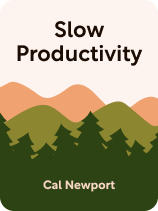

This article is an excerpt from the Shortform book guide to "Slow Productivity" by Cal Newport. Shortform has the world's best summaries and analyses of books you should be reading.
Like this article? Sign up for a free trial here.
What is slow productivity? How is it different from the traditional approach to work?
With the concept of slow productivity, Cal Newport offers a refreshing alternative to our fast-paced work culture. This approach encourages a more deliberate and focused way of working, prioritizing quality over quantity. It’s about finding a sustainable rhythm that allows for deeper engagement with tasks.
Read more to discover how slow productivity is a new approach to work and achievement.
What Is Slow Productivity?
Instead of the typical fast-paced work environment we’ve grown accustomed to, Newport advocates slow productivity. So, what is slow productivity? It’s doing fewer things at a natural pace, with a greater focus on quality. Newport’s vision of a more sustainable way to work borrows from time-tested practices of traditional knowledge workers such as writers, artists, and scientists.
For example, naturalist Charles Darwin exemplified slow productivity in his scientific endeavors. Rather than rushing through experiments and publications, Darwin took over 20 years to meticulously gather data, conduct experiments, and refine his theories before publishing On the Origin of Species. This deliberate and unhurried approach allowed him to produce a highly impactful and groundbreaking work that has stood the test of time.
(Shortform note: The ethos of slow productivity has roots in the established wisdom of effective personal management. For example, classic time management and effectiveness literature, such as Stephen Covey’s The 7 Habits of Highly Effective People (1989), often emphasizes prioritization, effectiveness over efficiency, and the importance of renewing yourself as key components of sustainable productivity. While not termed “slow productivity,” these elements dovetail with the notion that quality and intentionality trump sheer speed and volume of work.)
Newport argues that slow productivity can help modern workers feel less overwhelmed. This approach challenges the norm that values speed and quantity over quality. Instead, Newport suggests that consistent, meaningful effort leads to real productivity. His goal is to offer practical advice for a better workflow and to change how we view productivity, emphasizing sustainability without lowering ambition.
(Shortform note: One of the ways slow productivity helps you feel less overwhelmed is by minimizing your cognitive load. Coined by John Sweller, Cognitive Load Theory suggests that our working memory has a limited capacity, and excessive multitasking or frequent task-switching can overwhelm it, leading to inefficiency and mental fatigue. By focusing on fewer tasks with greater depth, slow productivity helps manage and reduce cognitive load, ensuring you experience less mental fatigue and greater clarity, allowing you to feel less overwhelmed in your daily work.)
In his book, Newport outlines the three key principles of slow productivity: doing less, working at your own pace, and prioritizing quality over quantity. While he acknowledges that these principles were initially designed for freelancers and those with greater job autonomy, he argues they can also help people in more structured roles.
| How to Implement Slow Productivity in a Structured Workplace While Newport doesn’t go into detail about how to implement these principles in a more structured workplace, other authors, such as Laura Vanderkam (Off the Clock) and Greg McKeown (Essentialism), offer advice on how to adjust a traditional work structure to make room for slow productivity principles. They stress the importance of setting boundaries, clarifying your responsibilities, and maintaining a disciplined and focused approach to work through strategic scheduling, time blocking, and delegating nonessential tasks. They also propose recognizing and leveraging your peak productivity periods and proactively managing energy levels throughout the day. In more structured roles, adopting slow productivity principles may require having a dialogue with management to discuss and adjust job expectations and assess and streamline work processes, adopting new tools when necessary. |
Exercise: Prioritize Slow Productivity
Slow productivity encompasses three core principles: Do less, work at a natural pace, and do your best work. Carving out goals around these principles can steer you toward more sustainable and meaningful productivity.
- Which of Newport’s core principles resonates with you most or needs the most improvement in your current lifestyle? It could be either do less, work at a natural pace, or do your best work.
- Define a concrete goal associated with this principle. Ensure this goal is specific enough to provide a clear path, yet challenging enough to promote growth. For example, maybe your goal is to only have two major projects going on at any given time, or to implement a four-day work week.
- Consider what specific actions you’ll need to take to achieve this goal. What is a realistic timeline for achieving this goal?

———End of Preview———
Like what you just read? Read the rest of the world's best book summary and analysis of Cal Newport's "Slow Productivity" at Shortform.
Here's what you'll find in our full Slow Productivity summary:
- The flaws with the traditional definitions of productivity
- The principles of Cal Newport’s “slow productivity”
- Why doing less actually means you’re doing more






